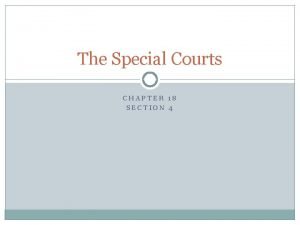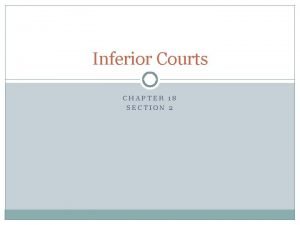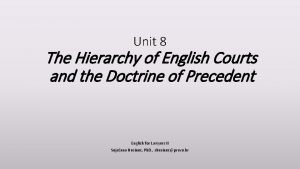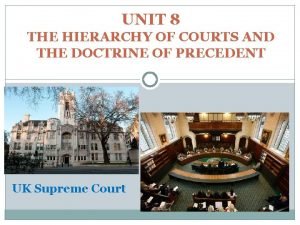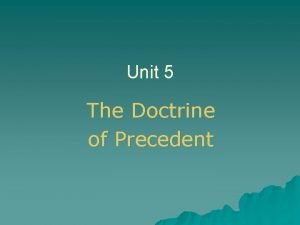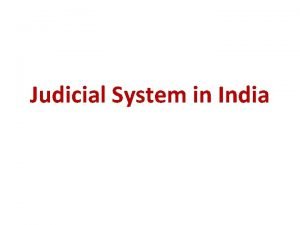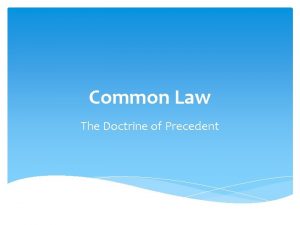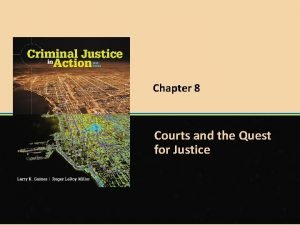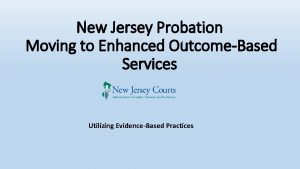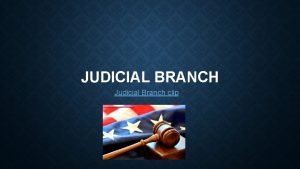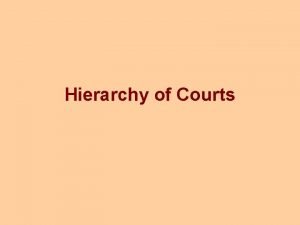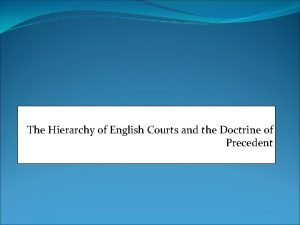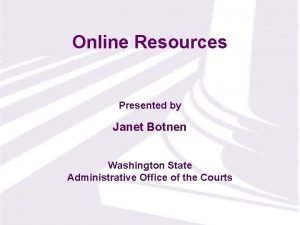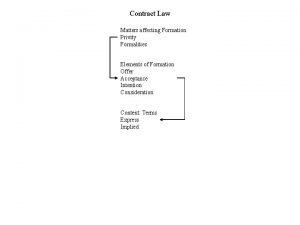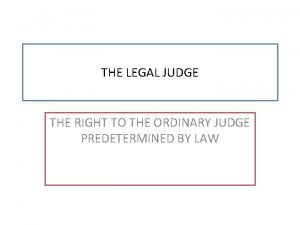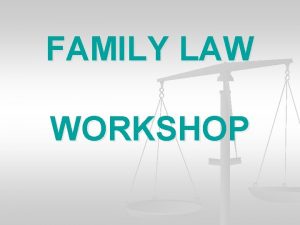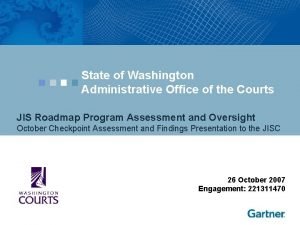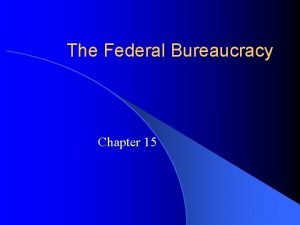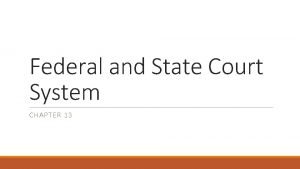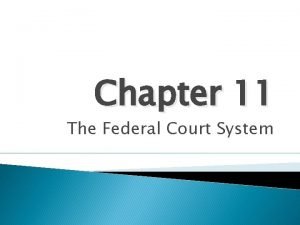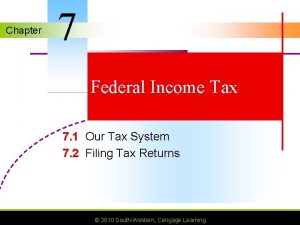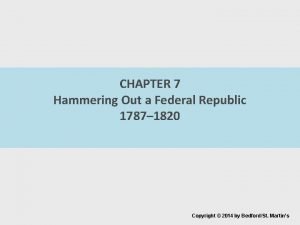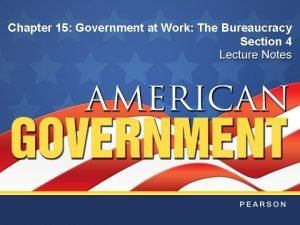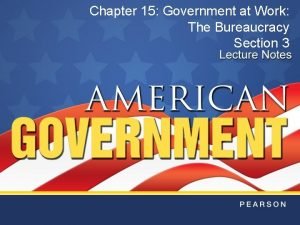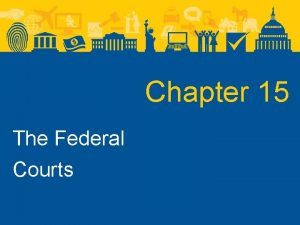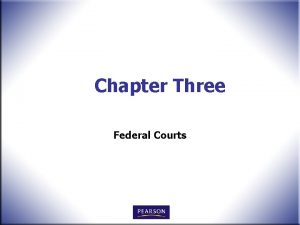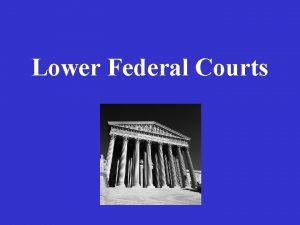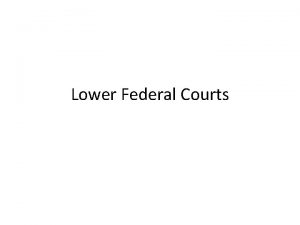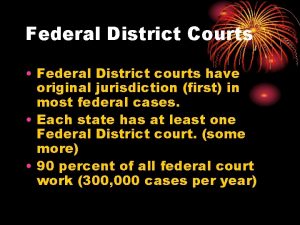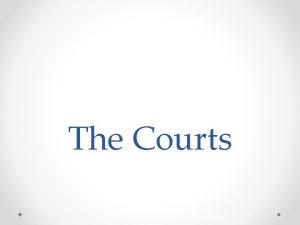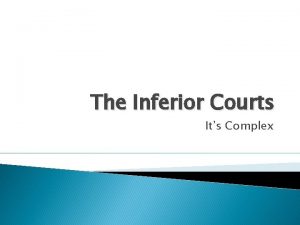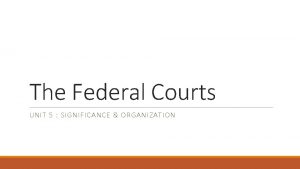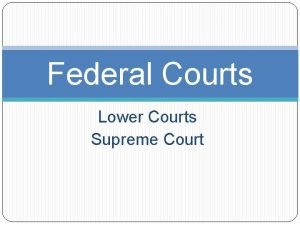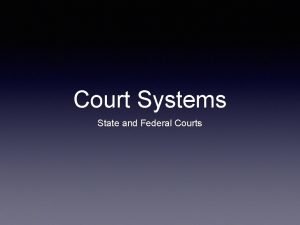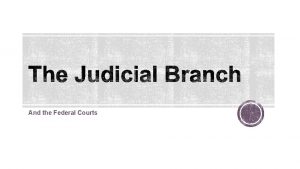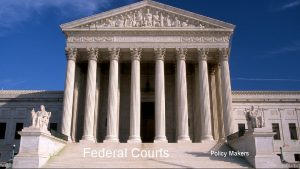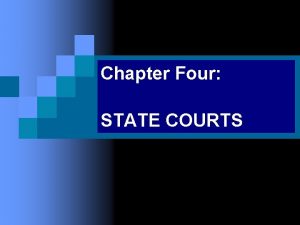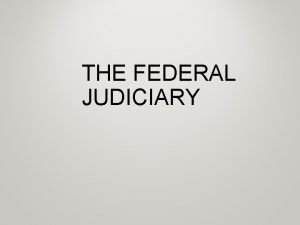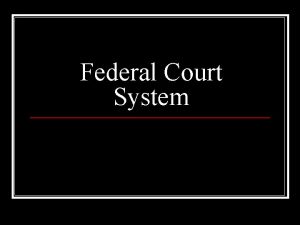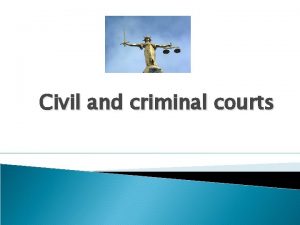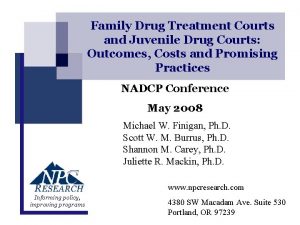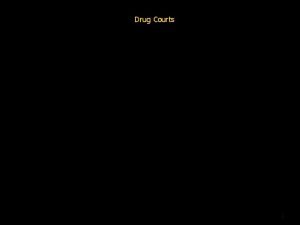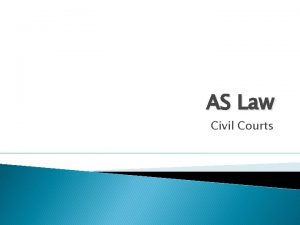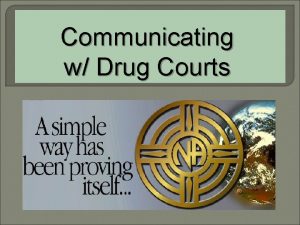Chapter 15 The Federal Courts The Federal Courts





























































- Slides: 61

Chapter 15 The Federal Courts

The Federal Courts

The Legal System • “A government of laws and not of men. ”-John Adams, describing the new Massachusetts state constitution • Rule of law: all are equal before the law and none are immune from it. – Fundamental fairness expectation Americans have of the judicial system • “That’s not fair” is a tacit reference to rule of law

The Legal System • Criminal law: the branch of law that regulates the conduct of individuals, defines crimes, and specifies punishments for criminal acts. – – Government is always the plaintiff Defendant cannot be forced to testify Standard: guilty beyond a reasonable doubt Penalties: fines, public service, imprisonment, death

The Legal System • Civil law: the branch of law that deals with disputes that do not involve criminal penalties. – – Plaintiff is the party that has been legally wronged Defendant can be forced to testify Standard: preponderance of evidence Penalties: typically monetary

The Legal System • Precedent: previous decisions from prior cases that are used to understand how a law is applied • Stare decisis: “let the decision stand” – The use of precedent in a current case – The court is hesitant to overturn precedent

Types of Courts • State versus federal • Trial versus appellate • State supreme court

The U. S. Court System

Types of Courts • State vs. federal courts – Depends on the law in question • Federal law Federal court • State law State court • State cases can be appealed in the federal system if there has been a violation of the U. S. Constitution.

Types of Courts • Trial vs. appellate – Trial courts apply law to the facts of a given case. • Facts of the case are introduced • Judges and juries make sense of how facts relate to law. • Trial cases take both law and precedent into account.

Types of Courts • Trial vs. appellate – Appellate courts examine whether the law has been applied correctly in a trial court case. • New facts cannot be introduced. • If new facts are available, the case goes back to a trial court. • Appeals courts hear fewer cases than trial courts – Typically dwell on complicated elements – Sole concern: whether laws applied correctly

The Supreme Court

Types of Courts • Supreme Court – The court of last resort – Has final interpretation over the Constitution and statutory law, be it state or federal – No state constitution can run contrary to the federal constitution – Recall, the Supreme Court is an appellate court • No new facts allowed

Types of Courts • Jurisdiction: where court has authority, power • Federal court domain includes: – – Cases between states Ambassadors Federal law U. S. Constitution • State and local courts have no say in the kinds of cases listed above.

The Federal Courts

Types of Courts • Federal courts: – – – – 94 judicial districts, plus three for territories 11 regional circuits, plus one for the District of Columbia U. S. Court of International Trade U. S. Court of Federal Claims U. S. Court of Appeals for the Federal Circuit U. S. Court of Veterans Appeals U. S. Court of Military Appeals

Types of Courts • Habeas corpus – A prisoner can appeal for a writ of habeas corpus to a court, claiming a violation of rights. – For a federal court to intervene in a state case, the prisoner must argue that a federal right has been violated.

Federal Jurisdiction • In 2008: – Federal district courts heard 349, 969 cases. – Federal courts of appeal heard 61, 104 cases. – U. S. Supreme Court heard 75 cases. • Procedures of note – Only hear appeals they determine have merit – Three judges on the panel (no jury)

Federal Trial Courts • Original jurisdiction: the ability to hear a case for the first time • Appellate jurisdiction: the power to hear appeals from a lower court

Federal Appellate Courts • 89 courts in 50 states, +1 Puerto Rico, +1 D. C. , three territories – Staffed by 679 judges – Almost always one judge per case • All areas of the United States and territories are covered by one of 12 circuit courts. – Each court has six to 28 judges. – Each trial usually has three judges.

Federal Appellate Courts

How Judges Are Appointed

The U. S. Supreme Court • Nine justices – Chief justice and eight associate justices • System of equals, which functions on seniority basis • All judges have equal say, and each has one vote. • If chief justice sides with the majority opinion, he assigns the writing of the majority opinion. • If chief sides with the minority opinion, the most senior justice in the majority does.

How Judges are Appointed • Senatorial courtesy – Senators from the president’s party suggest nominees for district courts in their state when an opening appears. – President chooses from the list, then the Senate confirms. – The confirmation process has become highly political in recent decades.

Supreme Court Justices, 2009 (in Order of Seniority)

WHO ARE AMERICANS? Who Are Federal Judges? CHAPTER 15

WHO ARE AMERICANS? Federal Judges in 2009, by Race and Gender White men 860 African American men 84 Hispanic men 58 White women 225 African American women 40 Hispanic women 26 = 10 federal judges SOURCE: Russell Wheeler, “The Changing Face of the Federal Judiciary” (Washington, DC: Brookings Institution, 2009). Data are from August 2009.

WHO ARE AMERICANS? Appointments to Federal Courts, by Administration KENNEDY/J OHNSON NIXON/ FORD CARTER REAGAN G. H. W. BUSH CLINTON G. W. BUSH OBAMA White men White women African American women Hispanic women Asian America men 93% 95% 66% 86% 72% 52% 67% 36% 1% <1% 12% 7% 16% 23% 16% 27% 4% 3% 12% 1% 7% 12% 5% 10% <1% 1% 3% <1% 1% 4% 2% 7% 6% 5% 4% 6% 6% 5% <1% 2% 4% 5% 1% Asian American women SOURCE: Russell Wheeler, “The Changing Face of the Federal Judiciary” (Washington, DC: Brookings Institution, 2009). 2% 3%

The Power of the Supreme Court: Judicial Review

Judicial Review • Judicial review: the power of the courts to review and, if necessary, declare actions of the legislative and executive branches invalid or unconstitutional. • The U. S. Constitution does not mention judicial review. – Marbury v. Madison (1803)

Judicial Review of Acts of Congress • Supremacy Clause and Judicial Act of 1789 – All state laws and actions must be in conformity with the U. S. Constitution, federal laws, and treaties.

Judicial Review of State Actions

Judicial Review of Federal Actions • Congress’s dilemma: make laws too broad, and the executive branch can subvert them; make them too narrow, and they cannot adapt over time. • The Court is hesitant to overturn executive-branch decisions because Congress can do so.

Judicial Review and Presidential Power • Historically, the Court is hesitant to judge presidential authority during wartime. – Allowed imprisonment of Japanese Americans in WWII – Deferential to handling of “enemy combatants” during Iraq War

Judicial Review and Lawmaking

Judicial Review and Lawmaking • Common law: body of law stemming from judges, not from statutes – Allows courts to function in the absence of lawmaking, just as executive orders do • Appellate courts also make rules that apply to how courts decide cases.

Rules of Access • “Cases and Controversies”: there must be an actual dispute, not a hypothetical one. • Standing: a party must have standing to sue by being a stakeholder in the outcome. • Standing gives the legal right to initiate a case. • Mootness: a criterion used to dismiss cases that no longer require a resolution. – The issue is resolved; nothing to address.

Cases Filed in U. S. Supreme Court

Writ of Certiorari • SCOTUS is more likely to “grant cert” to cases where: – An important civil right or civil liberty is at stake. – Appellate courts have ruled differently on the same law, and it needs to be applied universally. – The federal government is filing the appeal.

Solicitor General • Federal government’s top lawyer – All cases before the Supreme Court are argued by an attorney from the solicitor general’s office, often by the solicitor general himself or herself. – When the solicitor general requests a writ of certiorari, the justices take the request extremely seriously.

Amicus Curiae • Amicus briefs can be filed by any stakeholder in a case, even if that person is not directly involved in the litigation. – Useful sources of legal interpretation and facts

Lobbying for Access • Some interest groups have long-term legal strategies. – Bring test cases under the most favorable circumstances – Bring cases in specific circuits, expecting the appeals court to side a certain way – Have access to top experts in the field

The Supreme Court’s Procedures

The Supreme Court’s Procedures

The Supreme Court’s Procedures • Preparation – Both sides submit briefs, as do other interested parties. – The attorneys will also prepare extensively for the questions they may face. – By the time a case reaches the Supreme Court, the original attorneys may be replaced by more experienced attorneys.

The Supreme Court’s Procedures • Oral argument – The Court meets three times per week when in session. – Each side gets a half hour, with many interruptions. – Sometimes, several different attorneys will address different aspects of the argument.

The Supreme Court in Action

The Supreme Court’s Decision-Making Process

The Supreme Court’s Procedures • The conference – Justices meet by themselves on Wednesdays and Fridays when in session. – Hold an initial vote – Chief justice or most senior justice will assign a justice to write the majority opinion. – Usually the dissenting opinion is assigned as well. – Most opinions are written by the clerks under the supervision of the justice.

Traditional Limitations on the Court • Standing limits the ability of many to bring issues into the courts. – Members of Congress have repeatedly tried to force the president to obey the War Powers Act. • The Court is willing to protect classes, but hesitant to remedy with broad reparations. • The Court has no mechanism to force the other branches to obey. • Congress can limit access to the Court.

Public Opinion Poll Do you think federal judges should be appointed for life terms, limited terms, or elected? a) Federal judges should be appointed for life. b) They should have limited appointment terms. c) Federal judges should be elected.

Public Opinion Poll Do you believe the decisions of the federal courts are primarily driven by legal doctrine or individual judge’s political ideology? a) Legal doctrine b) Political ideology

Public Opinion Poll Do you believe members of the U. S. Senate should have the ability to block the judicial nominations based solely on the nominee’s political ideology and party? a) Yes b) No

Public Opinion Poll Do you believe the U. S. Supreme Court should televise or online stream their proceedings? a) Yes b) No

Public Opinion Poll Compared to the presidency and the Congress, do you think the Court has too little, too much, or the right amount of influence on American policy and law? a) Too little influence b) Too much influence c) About right amount

Chapter 15: The Federal Courts • Quizzes • Flashcards • Outlines • Exercises wwnorton. com/we-the-people

Following this slide, you will find additional images, figures, and tables from the textbook.

Cases and the Law

Digital Citizens

Two Judicial Revolutions

The Supreme Court and International Law
 The special courts
The special courts The inferior courts chapter 18 section 2
The inferior courts chapter 18 section 2 Hierarchy of english courts
Hierarchy of english courts Levels of court uk
Levels of court uk Doctrine of precedent
Doctrine of precedent Tennis courts wolverhampton
Tennis courts wolverhampton Judiciary system in india
Judiciary system in india Courts hierarchy
Courts hierarchy 4 levels of state courts
4 levels of state courts Fare program arizona state courts
Fare program arizona state courts Courts hierarchy
Courts hierarchy New jersey courts
New jersey courts Judicial restraint clipart
Judicial restraint clipart Jurisdiction of high court
Jurisdiction of high court English courts hierarchy
English courts hierarchy Inside courts wa
Inside courts wa When will the courts imply terms into a contract
When will the courts imply terms into a contract The indolent judge
The indolent judge Why art thou yet so fair
Why art thou yet so fair State courts us
State courts us Family law facilitator
Family law facilitator Washington administrative office of the courts
Washington administrative office of the courts Chapter 15 the federal bureaucracy
Chapter 15 the federal bureaucracy Lower court
Lower court The federal court system chapter 11 answer key
The federal court system chapter 11 answer key Chapter 7 federal income tax
Chapter 7 federal income tax Apush chapter 7 hammering out a federal republic
Apush chapter 7 hammering out a federal republic Which trend characterized thomas jefferson's presidency?
Which trend characterized thomas jefferson's presidency? Chapter 15 section 1 the federal bureaucracy answer key
Chapter 15 section 1 the federal bureaucracy answer key Chapter 15 government at work the bureaucracy
Chapter 15 government at work the bureaucracy Hát kết hợp bộ gõ cơ thể
Hát kết hợp bộ gõ cơ thể Frameset trong html5
Frameset trong html5 Bổ thể
Bổ thể Tỉ lệ cơ thể trẻ em
Tỉ lệ cơ thể trẻ em Gấu đi như thế nào
Gấu đi như thế nào Chụp phim tư thế worms-breton
Chụp phim tư thế worms-breton Chúa sống lại
Chúa sống lại Các môn thể thao bắt đầu bằng tiếng đua
Các môn thể thao bắt đầu bằng tiếng đua Thế nào là hệ số cao nhất
Thế nào là hệ số cao nhất Các châu lục và đại dương trên thế giới
Các châu lục và đại dương trên thế giới Công thức tính độ biến thiên đông lượng
Công thức tính độ biến thiên đông lượng Trời xanh đây là của chúng ta thể thơ
Trời xanh đây là của chúng ta thể thơ Cách giải mật thư tọa độ
Cách giải mật thư tọa độ Phép trừ bù
Phép trừ bù độ dài liên kết
độ dài liên kết Các châu lục và đại dương trên thế giới
Các châu lục và đại dương trên thế giới Thể thơ truyền thống
Thể thơ truyền thống Quá trình desamine hóa có thể tạo ra
Quá trình desamine hóa có thể tạo ra Một số thể thơ truyền thống
Một số thể thơ truyền thống Bàn tay mà dây bẩn
Bàn tay mà dây bẩn Vẽ hình chiếu vuông góc của vật thể sau
Vẽ hình chiếu vuông góc của vật thể sau Biện pháp chống mỏi cơ
Biện pháp chống mỏi cơ đặc điểm cơ thể của người tối cổ
đặc điểm cơ thể của người tối cổ Giọng cùng tên là
Giọng cùng tên là Vẽ hình chiếu đứng bằng cạnh của vật thể
Vẽ hình chiếu đứng bằng cạnh của vật thể Tia chieu sa te
Tia chieu sa te Thẻ vin
Thẻ vin đại từ thay thế
đại từ thay thế điện thế nghỉ
điện thế nghỉ Tư thế ngồi viết
Tư thế ngồi viết Diễn thế sinh thái là
Diễn thế sinh thái là Dạng đột biến một nhiễm là
Dạng đột biến một nhiễm là
